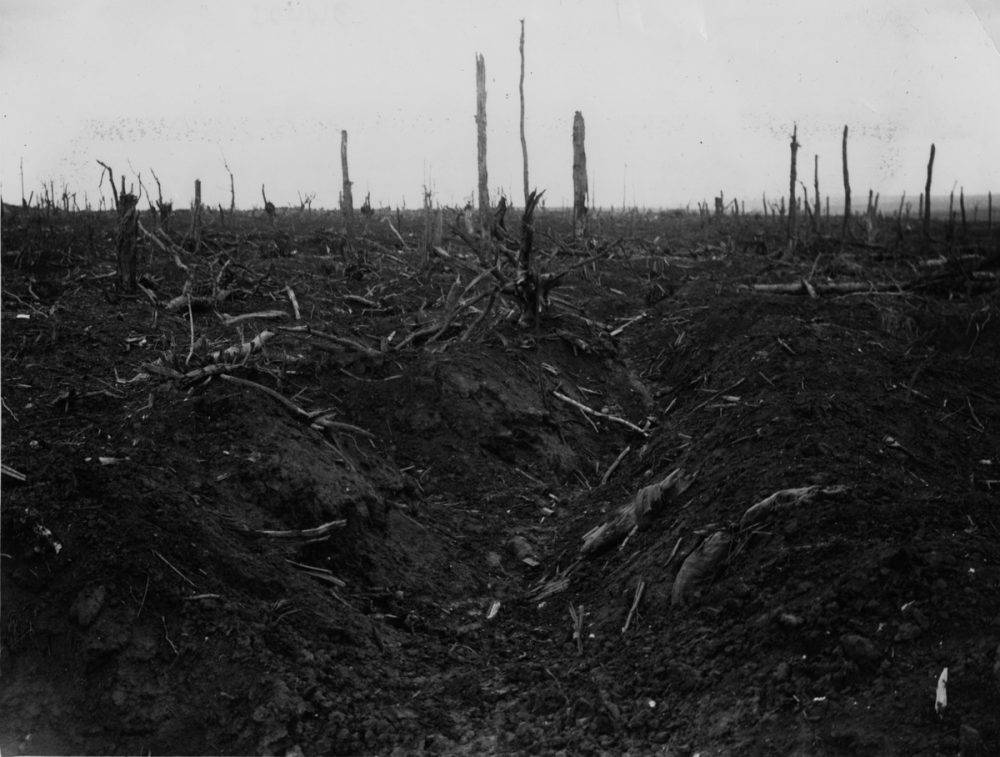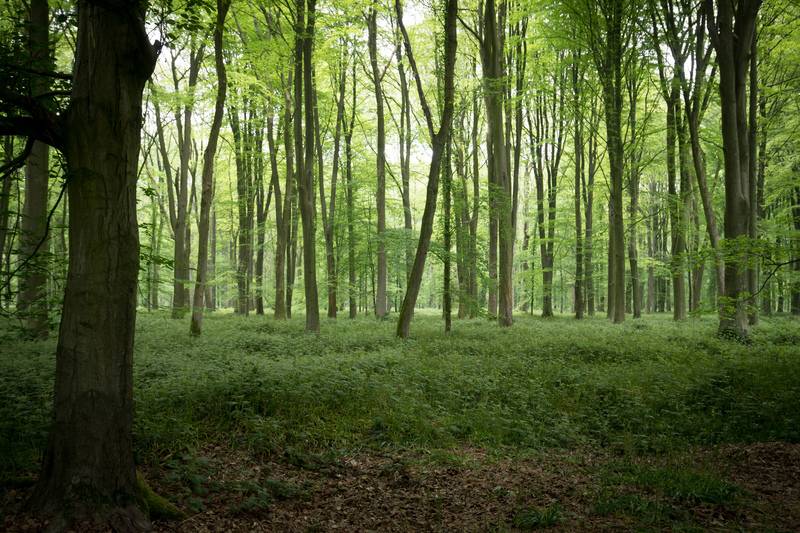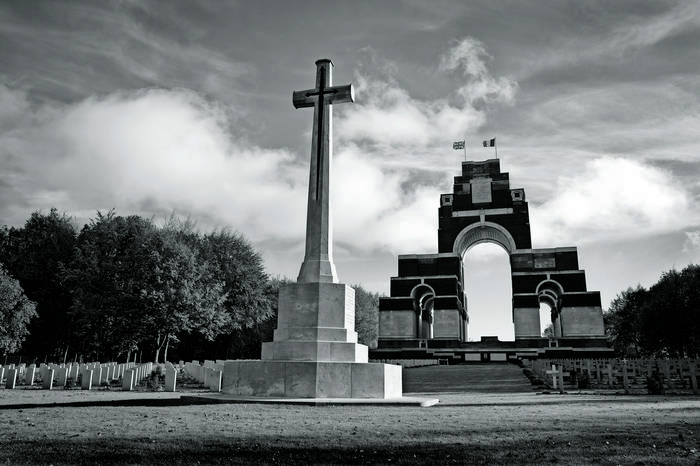The fallen: The Cenotaph and two statues in Cape Town are in remembrance of both World Wars, showing the Western Front, the East African Campaign and the Battle of Delville Woods. Photo: Jaco Marais/Getty Images
In November each year a two-minute silence is observed at 11am on the 11th day, the exact hour, date and month on which hostilities in World War I ceased.
In South Africa, this simple act of remembrance seems to be mainly observed by diminishing numbers of veterans organisations, due in no small part to it being seen by many as a historical overhang from a colonial past.
Remembrance of soldiers who died in battle is a recent phenomenon in the long history of war. In contrast, there are many monuments to military leaders and their victories ranging from ancient Roman triumphal arches to Nelson’s Column in Trafalgar Square.
The rank and file of armies that fought each other were mostly made up of the forgotten members of society often press-ganged into the armed forces. War was also something that happened far away from the home front and casualties numbered in the thousands rather than in the millions.
World War I changed all of that. Many of those who died in battle were volunteers, including from the educated middle and working classes. The sheer number of dead, who were killed by modern weapons of mass annihilation, meant that no household was left untouched by death or injury.
The scale of the dead was such that it was impractical to return their bodies to their loved ones and mass neglected graves were no longer acceptable to a modern society. And so commenced a system of documenting the war dead and marking the graves of soldiers. By the end of World War II, the standard of identifying and remembering those that died in war would be set for generations to come.
South Africa’s role in the memorialisation of the war dead is not insignificant. Although the number of South Africans who died in World War I pales in comparison to that of the main combatants, South Africans did not escape the wholesale slaughter that characterised the Western Front, which is epitomised in the battle for Delville Wood.
 Shattered: A German trench in Delville Wood. The battle was fought from 5 July to 3 September. South African troops, including non-combatants, were brought in to cover the flanks of the British. Only 750 of the 3 433 survived. Photo: Robert Hunt Library/Windmill Books/UIG/Getty images
Shattered: A German trench in Delville Wood. The battle was fought from 5 July to 3 September. South African troops, including non-combatants, were brought in to cover the flanks of the British. Only 750 of the 3 433 survived. Photo: Robert Hunt Library/Windmill Books/UIG/Getty images
Early on the morning of 15 July 1916, about 3 000 officers and other ranks of the 1st South African Infantry Brigade were massed on the edge of Delville Wood, near the village of Longueval in the Somme Valley region of France. Two weeks earlier, on 1 July, hundreds of thousands of British, French and soldiers of the then British Empire had commenced a large-scale attack on entrenched German and Austro-Hungarian forces along a 24-kilometre front on both sides of the banks of the Somme River.
This Somme offensive was designed to relieve the beleaguered French forces at Verdun and break the stalemate that had prevailed on the Western Front from the end of 1914.
Led by Lieutenant Colonel William Tanner under direction of Brigadier General Henry Lukin, the South Africans had been ordered by the British High Command to take and hold the one square kilometre Delville Wood “at all cost”.
At first the South African forces encountered little resistance advancing into Delville Wood and, by 2pm on 15 July, Tanner reported that all but a heavily defended northern corner of the wood had been captured. Anticipating a German counter-attack, Tanner ordered his men to dig trenches from which to defend their positions.
But it soon became clear that this would be virtually impossible because of the heavy undergrowth and root systems of the oak and other trees that made up Delville Wood. The tragic results of not being able to properly entrench themselves became apparent when the first of many German bombardments were aimed at the easily identifiable target of Delville Wood in the middle of surrounding open fields.
Persistent German counterattacks, each preceded by a bombardment, were staved off, often with savage close quarter fighting. The 16th and 17th of July passed much in the same way. By 18 July, the German forces, unable to dislodge the exhausted South African troops, intensified the bombardment of the wood. From 8am until 7pm on 18 July, German artillery fired thousands of high explosive and gas-filled shells and reduced Delville Wood to the moonscape, typical of many photos of the Western Front. At times 400 shells a minute were falling on the hapless South Africans.
Heavy shelling and control of most of the surrounding area by German forces limited the ability of the Allied forces to relieve the South African position and evacuate the wounded. Tired and exhausted, many troops even fell asleep during the deafening bombardments.
The German counter-attack, following on from the bombardment of 18 July, resulted in most of the gains of 15 July being reversed and the South African troops pushed back to the southern corner of the wood. On 20 and 21 July, the remaining South African troops were relieved by replacement British forces.
The battle for what was left of Delville Wood and surrounding area would continue until 3 September, when Allied forces finally gained control of the area.
Of the 3 143 South African troops who fought in and around Delville Wood, only 29 officers and 751 other ranks answered the roll call on 21 July, the balance being listed as killed, wounded or missing. Those who walked away from the battlefield included Private William Faulds, who was awarded the Victoria Cross after rescuing wounded men on successive days from no-man’s land.
At the end of the battle only one tree remained relatively intact in Deville Wood, and survives today. Three crosses were crafted from the broken trees and returned to South Africa, one of which weeps resin every year on the anniversary of the battle.
The death and destruction experienced at Delville Wood was replicated thousands of times during the Battle of the Somme. At the end of the campaign, one million soldiers from both sides lay dead or were wounded and the total Allied advance measured just 10 kilometres at its furthest point.
The task of identifying and burying the war dead was not administratively advanced at the beginning of World War I.
This Herculean task fell to a volunteer Red Cross unit leader, Major General Fabian Ware. Ware, who had spent time in South Africa as an administrator shortly after the Second Boer War, was horrified by the numbers of unidentified bodies and graves of soldiers who died in the field. His fledging Graves Registration unit would eventually expand and become what is now known as the Commonwealth War Graves Commission.
Vast tracts of land were secured for burials in France and Belgium. It was decided that these soldiers were better honoured by being buried next to their comrades at the scene of the battle where they fell.
A decision was also taken that men and women of all ranks would share the same simple white headstone. The headstones of those who could not be identified are marked simply as “A soldier of the Great War, known unto God”, an epitaph suggested by Rudyard Kipling, whose own son, Jack, was killed on the Western Front.
To memorialise the hundreds of thousands of the “missing”, imposing structures were constructed on the sites of significant battles. Designed by the leading architects of the time, such as Herbert Baker and Edwin Luytens, these memorials bear the names of the thousands whose bodies have never been found, vaporised in the intense shelling or buried deep in the mud of trenches and fields.
Luytens, whose first war memorial was the Rand Regiments Memorial in Johannesburg (dedicated to casualties of the Second Boer War), was also the designer of the Cenotaph in London, which was to become the United Kingdom’s official war memorial.
 Revival: Trees in the Delville Wood South African National Memorial in Longueval, France, were grown by the Kirstenbosch botanical garden and two rows of oaks from trees cultivated by a French Huguenot who came to South Africa in the 1600s. Photo: Matt Cardy/Getty Images
Revival: Trees in the Delville Wood South African National Memorial in Longueval, France, were grown by the Kirstenbosch botanical garden and two rows of oaks from trees cultivated by a French Huguenot who came to South Africa in the 1600s. Photo: Matt Cardy/Getty Images
The ground on which the Delville Wood cemetery is located was secured by Percy Fitzpatrick (he of Jock of the Bushveld fame) and handed to the South African government. Herbert Baker designed the first memorial to the fallen at Deville Wood, which was unveiled in 1926, replicas of which stand at the Union Buildings and the Company’s Gardens in Cape Town.
Deville Wood itself was restored to its original footprint and replanted from trees grown by the Kirstenbosch National Botanical Garden. Two rows of oak trees line the long grassy avenue from the graveyard to the memorial. Each of these oak trees was cultivated from acorns collected from the same tree that had germinated from one of the six acorns that French Huguenot Jean Gardiol had brought to South Africa in 1688 from France.
In 1986, on the 70th anniversary of the battle, a further memorial in the shape of the Castle of Good Hope in Cape Town was added behind the original memorial.
During World War I, a two-minute silence had been observed sporadically in churches in South Africa, including those attended by Percy Fitzpatrick. In Cape Town, the mayor, Sir Harry Hands, whose son had also been killed on the Western Front, initiated a daily two-minute silence signalled by the firing of the noon day gun on Signal Hill for a full year from 14 May 1918 to 14 May 1919.
One minute of the silence was a time of thanksgiving for those who had returned alive, the second minute was to remember the fallen. As the city fell silent that first day, a bugler sounded the Last Post, and the Reveille was played at the end of the pause.
In 1919, Fitzpatrick, struck by this simple act of remembrance, petitioned King George V to formalise a two-minute silence to be observed each year on the anniversary of the end of World War I. As a result, the king invited all Commonwealth countries to observe an annual two-minute silence on Armistice Day (also called Remembrance Day and Poppy Day, commencing on 11 November 1919.
A copy of King George V’s letter can be seen in the Ditsong National Museum of Military History in Saxonwold, Johannesburg.
This act of remembrance now encompasses the remembrance of those who died in subsequent wars.
 Memory: The Thiepval Memorial has the names of 73 357 British and South African forces who died in the Somme battle and have no grave. The village of Thiepval was destroyed. Photo: Tom Stoddart/Getty Images
Memory: The Thiepval Memorial has the names of 73 357 British and South African forces who died in the Somme battle and have no grave. The village of Thiepval was destroyed. Photo: Tom Stoddart/Getty Images
While Deville Wood is the most iconic battle of South African forces in World War I, much criticism has rightly been levelled at the failure of successive South African governments to recognise the achievements of South Africans of other races who volunteered to serve in that war, including members of the South African Native Labour Corps who volunteered to join the Union Defence Force. When the SS Mendi was accidentally rammed and sank near the Isle of Wight, 607 of the non-combatants lost their lives.
Today the Delville Wood memorial commemorates all the fallen of the wars since World War I, including the Korea War, the South African Border War and the internal conflict.
South Africa was not alone in failing to commemorate all of its war dead. In 2022, the Commonwealth War Graves Commission report noted that hundreds of thousands of Commonwealth casualties from World War I, mostly African and Middle Eastern, were not commemorated by name, or at all, blaming pervasive racism and contemporary imperial attitudes.
While the passage of time may explain why the war dead from these global conflicts are no longer remembered, the reason for the muted remembrance of the war dead from more recent conflicts, such as the border war, is perhaps explained by the fact that the dead are tarred with the same brush as those who sent them to war. But to do so is to not know why soldiers fight and how they die.
Over the centuries, ideology or religion may be the reason soldiers are sent to war, but it is not why they fight or die. Ask any conscript in the South African Defence Force (1957 until 1994), of whatever political persuasion, where they would rather have been, it would not have been serving in the SADF. Ask any soldier why they fought, they will tell you they did so because they did not want to let their buddies down.
Ask any soldier who survived how his fellow soldiers died, they will tell you they died screaming for their loved ones or asking for someone to hold them for one last touch of comfort as their life slipped away. No one died in battle shouting praises for the regime that sent them to war.
The act of remembrance is also misconstrued as an act of celebration of war. But you need only watch any Remembrance Day service to know that this is not true. The act of remembrance is about the recognition of the futility of war and mourning the loss of men and women whose future ended too soon in the face of inhuman circumstances.
Next year, a memorial to the South African Native Labour Corps will be unveiled in Cape Town and the opportunity presents itself for civil society to participate in the act of remembrance and reconciliation in an ever increasingly divided society.
What better advocate for peace and humanity can there be that once bitter enemies stand together for two minutes of silence to remember the human cost of conflict?
As poet Laurence Binyon wrote in To the Fallen, “At the going down of the sun and in the morning/ We will remember them.”
This is an updated version of an article first published online in the Mail & Guardian on 24 January 2022. Shaun Read is the founder of Read Advisory Services.